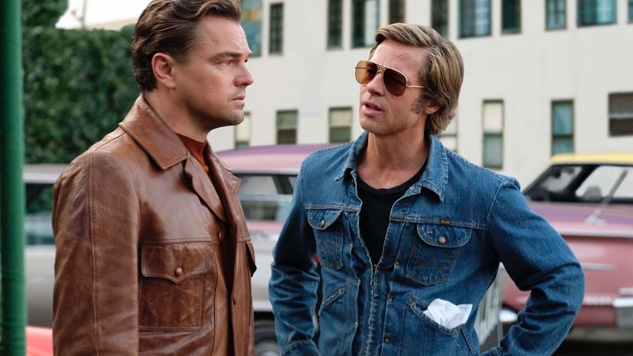
Since his first film, director Quentin Tarantino has made hundreds of references to the popular culture of the past. Whether it be via character dialogue or a background reference, Tarantino throughout his career has continually paid tribute to the medium that has given him so much as a filmmaker. But with his latest release, Once Upon A Time in Hollywood, the auteur director creates the penultimate tribute to the shifting tides of the industry’s golden age. Between the scene direction, witty dialogue, and exceptional on-screen chemistry between stuntman Cliff Booth (Brad Pitt) and fading television star Rick Dalton (Leonardo Di Caprio), this film is by far one of the best in the director’s filmography.Â
Setting and Plot
One of this film’s greatest assists is its atmosphere and setting which give a sense of gravitas to the main characters. Every shot holds a foreground and background dichotomy that places the viewer directly in the middle of 1960s Hollywood. There is not a single instance where one does not feel as if they are not in the film’s world setting. Tarantino makes a brilliant decision in starting the plot with a promotional video for Rick Dalton’s fictionalized Western series Bounty Law. Clearly a commentary on the death of the old Western series that the filmmaker grew up on and the ending of Dalton’s series mirrors the fading of his own career in the face of a changing world. Both Dalton and Booth share remarkable on-screen chemistry that helps anchor the entire plot.Â
The film is chock full of pop-cultural references, especially with the appearance of Damian Lewis as a young Steve McQueen and Mike Moh as Bruce Lee. Such a mix of real-life and fictionalized stars in the milieux of a shifting 60s counter-culture helps unify the themes of the plot. Change being predominantly the main point of focus for Tarantino. Dolton knows his time is numbered and he must either leave the comfortable media of being a TV B star or get swept up the torrents of faded Hollywood celebrities who just couldn’t keep up with the time. This is the main plot motive that propels the action forward. Not a single act or character, but the era and atmosphere of the 60s that guides the exposition forward.Â
This film is all about ambiance and background details, ranging from old movie posters to vintage actor icons of the era. Cinematographer Robert Richardson does a stunning job in capturing Tarantino’s vision of his time growing up in Hollywood during its fabled golden age. With a simple pan or rack focus shot, Richardson exposes more in terms of a metaphor than any long-winded dialogue can hope to achieve with lesser work. Tarantino l’s latest work not only pays homage but also provides viewers with an interesting alternative history on many famed events that both enchanted and horrified lovers of old Hollywood.Â
The Acting and Visual Style
Besides its amazing plot and world setting, one of the film’s strengths comes from its colorful casting choices. Both DiCaprio and Pitt give mesmerizing performances as two friends just trying to survive the Hollywood grind in a world that is simply passing them by. Margot Robbie (Sharon Tate) provides a noteworthy impression as the actress who was brutally murdered. A sense of dread always follows her naïveté in this world of drugs and hippie fueled innocence. Yet Robbie never gives in to cheap impersonation and overly stylized revisionism of Tate’s persona.Â
Tarantino’s cast is spot-on in this retro romp and not a single on-screen celebrity guest appearance. The music too is perfect in giving the audience a 60’s vibe. From the carefree parties at Tate’s pool parties to the long shots of Booth driving around in Dolton’s Cadillac up Hollywood boulevard, the Soundtrack never brakes hold of the time it takes place in. The camera work and occasional jump cuts render a vintage flair to the visual imagery of the setting. Such nuances are a necessary touch from a master director who takes time in placing every object and scenery in its rightful place. From a visual perspective, Tarantino presents a series of long shots that juxtapose startlingly from the decadence of the free-loving 1960s. Big cars and folk-pop music sound through the streets leading up to the demure atmosphere of Cielo Drive. Again contrasting images of faded Hollywood with decadent life of celebrity suburbia. Tarantino does this a lot with his images and actors On screen. Such a directing motif adds to the thematic elements of the plot and it greatly gives validity to the shifting counter-cultural tides of that era.  In the end, between the acting, screenwriting, plot, and stylistic choices, Once Upon a Time in Hollywood is a tour de force in the few days of a fading television star.Â
The Verdict
Tarantino strikes gold with his latest masterwork that recaptured a time when Western stars and hippy culture collided in a sprawling Hollywood bygone era. This latest effort barely skips a beat in terms of its quality and dedication to replicating the innocence of a swinging 1960s. Both DiCaprio and Pitt steal the show in this part fictionalized history part busy film that never deals like your in a modernist take on past generational culture. This is by far one of Tarantino’s best works and it is the summation of everything the artist replicated in his own work while paying homage to his fore-bearers.Â


Leave a Reply